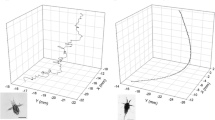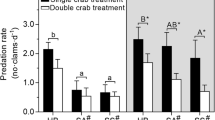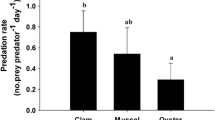Abstract
The rate and behavioral parameters of predation by the swimming crab Portunus trituberculatus on Manila clams Ruditapes philippinarum were measured with a video recording analysis system in aquaria. The type of functional response was determined, and the underlying behavior mechanisms displayed by swimming crabs preying on Manila clams were examined by linking the functional response parameters (a and T h) to foraging behaviors. Significant differences were observed in the swimming crab predation rate among different Manila clam densities (P < 0.001); predation rates of individual crabs offered clam densities of 2–8 clams/0.36 m−2 reached 1.37–2 clams/day−1, which increased with increasing clam density, but when crabs were offered clam densities of 10–50 clams/0.36 m−2, crab predation rates tended to be higher, at 2.13–2.25 clams/0.36 m−2. The parameters of functional response models, including a (rate of successful search, P = 0.455) and T h (handling time per prey, P = 0.472), were not significantly affected by clam density. The estimated a values were consistent with values derived from available behavioral data, whereas the T h values exhibited slight differences. Moreover, clam density significantly influenced crab foraging time budgets, encounter rates, the probability of capture upon encounter, and the probability of consumption upon capture (P < 0.001). The proportion of time crabs allocated to searching for and handling clams, and the probability of capture upon encounter, decreased with increasing clam density. A positive trend was detected for the encounter rate and the probability of consumption upon capture as clam density increased. These results, particularly in regard to the a and T h values, indicated that swimming crabs exhibit a type II functional response when preying on Manila clams in aquaria.




Similar content being viewed by others

References
Barbeau M, Scheibling RE (1994a) Behavioral mechanisms of prey size selection by sea stars (Asterias vulgaris Verrill) and crabs (Cancer irroratus Say) preying on juvenile sea scallops (Placopecten magellanicus Gmelin). J Exp Mar Biol Ecol 180:103–136
Barbeau M, Scheibling RE (1994b) Temperature effects on predation of juvenile sea scallops (Placopecten magellanicus Gmelin) by sea stars (Asterias vulgaris Verrill) and crabs (Cancer irroratus Say). J Exp Mar Biol Ecol 182:27–47
Barbeau M, Scheibling RE, Hatcher B, Taylor L, Hennigar A (1994) Survival analysis of tethered juvenile sea scallops Placopecten magellanicus in field experiments: effects of predators, scallop size and density, site and season. Mar Ecol Prog Ser 115:243–256
Barbeau M, Scheibling RE, Hatcher B (1998) Behavioural responses of predatory crabs and sea stars to varying density of juvenile sea scallops. Aquaculture 169:87–98
Boulding EG (1984) Crab-resistant features of shells of burrowing bivalves: decreasing vulnerability by increasing handling time. J Exp Mar Biol Ecol 76:201–223
Collins M, Ward S, Dixon A (1981) Handling time and the functional response of Aphelinus thomsoni, a predator and parasite of the aphid Drepanosiphum platanoidis. J Anim Ecol 50:479–487
Dayton PK (1984) Processes structuring some marine communities: are they general. Ecological communities: conceptual issues and the evidence. Princeton University Press, Princeton, New Jersey, USA, pp:181-197
Eggleston DB (1990a) Behavioural mechanisms underlying variable functional responses of blue crabs, Callinectes sapidus feeding on juvenile oysters, Crassostrea virginica. J Anim Ecol 59:615–630
Eggleston DB (1990b) Foraging behavior of the blue crab, Callinectes sapidus, on juvenile oysters, Crassostrea virginica: effects of prey density and size. Bull Mar Sci 46:62–82
Eggleston DB (1990c) Functional responses of blue crabs Callinectes sapidus Rathbun feeding on juvenile oysters (Crassostrea virginica Gmelin): effects of predator sex and size, and prey size. J Exp Mar Biol Ecol 143:73–90
Eggleston DB, Lipcius RN, Hines AH (1992) Density-dependent predation by blue crabs upon infaunal clam species with contrasting distribution and abundance patterns. Mar Ecol Prog Ser 85:55–68
Flagg P, Malouf R (1983) Experimental plantings of juveniles of the hard clam (Mercenaria mercenaria Linne) in the waters of Long Island, New York. J Shellfish Res 3:19–27
Gianguzza P, Di Trapani F, Bonaviri C et al (2016) Size-dependent predation of the mesopredator Marthasterias glacialis (L.)(Asteroidea). Mar Biol 163(3):1–11
Hassell MP (1978) The dynamics of arthropod predator-prey systems. Princeton University Press, Princeton
He M, Hong W, Li F (1986) Predators of manila clam Ruditapes philippinarum and control. J Fujian Fish 4:37–40
Holling CS (1959) Some characteristics of simple types of predation and parasitism. Can Entomol 91:385–398
Juliano S (2001) Nonlinear curve fitting: predation and functional response curves. Des Anal Ecol Exp 2:178–196
Kuhlmann ML, Hines AH (2005) Density-dependent predation by blue crabs Callinectes sapidus on natural prey populations of infaunal bivalves. Mar Ecol Prog Ser 295:215–228
Lafontaine YD, Leggett WC (1987) Effect of container size on estimates of mortality and predation rates in experiments with macrozooplankton and larval fish. Can J Fish Aquat Sci 44:1534–1543
Lipcius RN, Hines AH (1986) Variable functional responses of a marine predator in dissimilar homogeneous microhabitats. Ecology 67:1361–1371
Niu H, Nie H, Zhu D, Yang Y, Yan X (2015) Identification of EST_SSR markers associated with growth-related traits in the Manila clam Ruditapes philippinarum. Acta Ecol Sin 35:1910–1916
O’Brien WJ (1979) The predator-prey interaction of planktivorous fish and zooplankton: recent research with planktivorous fish and their zooplankton prey shows the evolutionary thrust and parry of the predator-prey relationship. Am Sci 67:572–581
Paine RT (1980) Food webs: linkage, interaction strength and community infrastructure. J Anim Ecol 49:667–685
Rindone RR, Eggleston DB (2011) Predator–prey dynamics between recently established stone crabs (Menippe spp.) and oyster prey (Crassostrea virginica). J Exp Mar Biol Ecol 407:216–225
Seitz RD, Lipcius RN, Hines AH, Eggleston DB (2001) Density-dependent predation, habitat variation, and the persistence of marine bivalve prey. Ecology 82:2435–2451
Sih A, Crowley P, McPeek M, Petranka J, Strohmeier K (1985) Predation, competition, and prey communities: a review of field experiments. Annu Rev Ecol Syst 16:269–311
Solomon ME (1949) The natural control of animal populations. J Anim Ecol 18:1–35
Soo P, Todd PA (2014) The behaviour of giant clams (Bivalvia: Cardiidae: Tridacninae). Mar Biol 161(12):2699–2717
Spitze K (1985) Functional response of an ambush predator: Chaoborus americanus predation on Daphnia pulex. Ecology 66:938–949
Streams F (1994) Effect of prey size on attack components of the functional response by Notonecta undulata. Oecologia 98:57–63
Sun Y, Wang F, Dong S (2015) A comparative study of the effect of starvation regimes on the foraging behavior of Portunus trituberculatus and Charybdis japonica. Physiol Behav 151:168–177
Taylor RJ (1984) Predation. Chapman and Hall, New York
Wang R, Wang Z, Zhang J (2008) Science of marine shellfish culture. China Ocean University Press, Qingdao
Wong MC, Barbeau MA (2003) Effects of substrate on interactions between juvenile sea scallops (Placopecten magellanicus Gmelin) and predatory sea stars (Asterias vulgaris Verrill) and rock crabs (Cancer irroratus Say). J Exp Mar Biol Ecol 287:155–178
Wong MC, Barbeau MA (2006) Rock crab predation of juvenile sea scallops: the functional response and its implications for bottom culture. Aquacult Int 14:355–376
Wong MC, Barbeau MA, Dowd M, Richard K (2006) Behavioural mechanisms underlying functional response of sea stars Asterias vulgaris preying on juvenile sea scallops Placopecten magellanicus. Mar Ecol Prog Ser 317:75–86
Acknowledgments
We thank Dr. Yangen Zhou and Jiamin Sun for their valuable advice in writing the article. This work was supported by a Key Project of Scientific and Technical Supporting Programmers funded by the Ministry of Science & Technology of China (Grant No. 2011BAD13B03), and the National Natural Science Foundation of China.
Author information
Authors and Affiliations
Corresponding author
Additional information
Responsible Editor: G. Chapman.
Reviewed by Undisclosed experts.
Rights and permissions
About this article
Cite this article
Sun, Y., Wang, F., Liu, D. et al. Behavioral mechanisms underlying the functional response of the swimming crab Portunus trituberculatus preying on the Manila clam Ruditapes philippinarum . Mar Biol 163, 124 (2016). https://doi.org/10.1007/s00227-016-2900-4
Received:
Accepted:
Published:
DOI: https://doi.org/10.1007/s00227-016-2900-4



